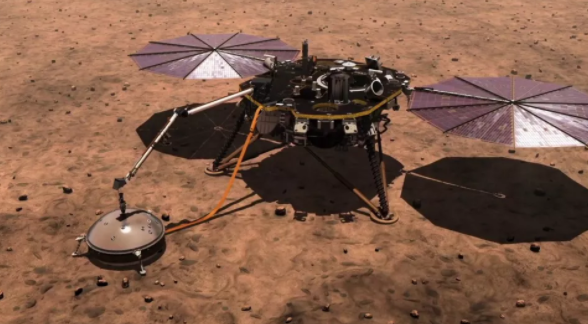The mysterious core of Mars is on the large side, NASA’s InSight lander data suggests
NASA's InSight lander has spent more than a full Martian year stationed on the Red Planet, and scientists are pleased with the spacecraft's observations to date, despite the challenges Mars has posed.
NASA’s InSight lander has spent more than a full Martian year stationed on the Red Planet, and scientists are pleased with the spacecraft’s observations to date, despite the challenges Mars has posed.
Although the safe arrival of NASA’s PERSEVERANCE ROVER last month has captured huge amounts of attention, it’s worth remembering that the agency has two other robots successfully operating on the Red Planet — the Curiosity rover and the stationary InSight lander.
And InSight just made some intriguing discoveries about the innards of Mars.
“We have met our science objectives about the interior structure, we’ve looked from the crust to the core, and measured our Martian seismicity,” Mark Panning, project scientist for InSight at NASA’s Jet Propulsion Laboratory (JPL) in Southern California, said during a live presentation on Wednesday (March 17) at the 52nd Lunar and Planetary Science Conference (LPSC), which was held virtually last week. “I’m just giving you the barest surface view.”
Insight on Mars
The $850 million InSight lander touched down on Mars in November 2018 for a mission designed to help scientists understand the interior of the Red Planet.
The lander was outfitted to conduct three different experiments: one focused on heat transfer, one on seismic waves and one on measuring the precise details of the planet’s spin.
Mars has not cooperated with the first experiment. InSight’s self-drilling heat probe, or “mole,” which was meant to bury itself up to 16 feet (5 meters) into the Red Planet, could never dig deeper than its own length. (Panning noted, however, that the instrument is gathering heat data for that much shallower section of crust.)
The other two experiments have gone more smoothly.
InSight’s seismometer was designed to scope out the internal structure of the Red Planet by feeling for seismic waves bouncing through and between the layers of Mars.
The instrument had detected about 500 events as of March 1, according to instrument principal investigator Philippe Lognonné, a geophysicist at the Paris Institute of Earth Physics in France, who gave a prerecorded talk at LPSC this week.
The third experiment uses radio science techniques to track the precise location of the lander in space. Since InSight, unlike Perseverance and NASA’s other rovers, isn’t moving along the surface, that data tells scientists how the planet itself is moving, letting them trace the tiny wobbles of its rotation axis.
Those wobbles to date suggest that the core of Mars is liquid, like the outer layer of Earth’s core, Panning said.
How big is Mars’ core?
Scientists are also using these observations to calculate the size of the core, with current best estimates ranging from 1,110 to 1,300 miles (1,780 to 2,080 kilometers) across. A second estimate of the same measurement produced by data gathered by InSight’s seismometer offers a narrower but complementary range, 1,120 to 1,160 miles (1,810 to 1,860 km), although this estimate isn’t final either, lead author Simon Stähler, a seismologist at the Swiss Federal Institute of Technology Zurich, emphasized in brief live remarks at LPSC on Thursday (March 18).
“That is a preliminary estimate that is not something you should build your own interior modeling upon, but at least it’s where we are landing,” he said. “And that is consistent with, if on the upper edge of, the pre-mission estimates.” Stähler also noted that until early this century, scientists thought that Mars’ core was closer to 930 miles (1,500 km) across.
That core estimate relies on measurements of seismic activity at a certain distance from the lander, with the seismic waves bouncing up to InSight’s instrument from the boundary where core and mantle meet.
However, the team would like observations of 10 such quakes, Stähler said during a longer recorded presentation. Right now, InSight has only confirmed three such signals, although eight more candidates could join the dataset.
Closer to the surface, scientists are still puzzling over what the seismometer’s observations say about the interior of Mars. Two different models match the data the instrument has gathered; one model proposes a thinner crust with two layers, the other a thicker crust with three layers, Mark Wieczorek, a seismologist at the Observatoire de la Côte d’Azur in France, said during brief live remarks. He and his colleagues hope that the observations InSight gathers during its extended mission will clarify the matter.
InSight is now in its extended mission, which will last for a second Martian year. (One Mars year is about 687 Earth days.)



